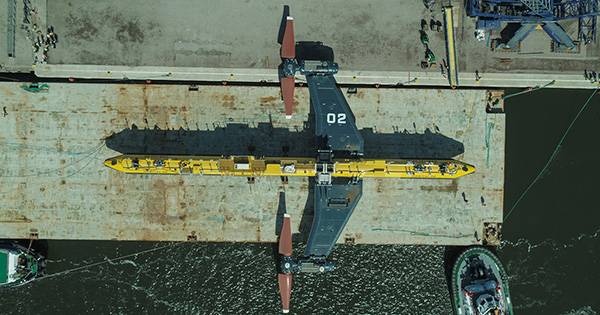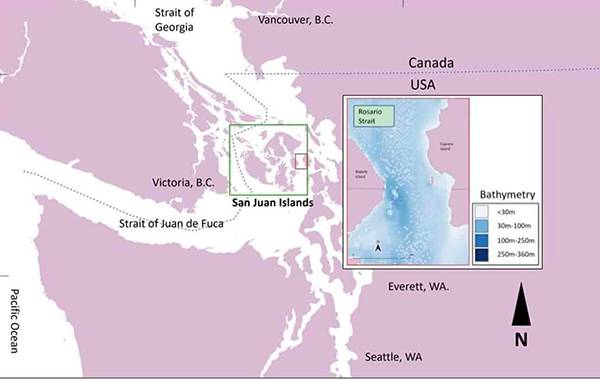
Tapping tidal flows for power generation has long been an elusive goal for clean-energy advocates. Formidable hurdles in logistics, technology and public acceptance make plans far from certain.
Orcas Power and Light Cooperative (OPALCO) has quietly launched an ambitious five-year campaign to bring tidal-power-generating capabilities to San Juan County waters.
Foster Hildreth, OPALCO’s managing director, seeks to explore “all possible technologies to build reliable, sustainable, and carbon-free resources to meet the energy needs of San Juan County.”
His enthusiasm for tidal power emerged in 2018 when he set OPALCO on an international quest to harness the daily tidal flows of Rosario Strait.
In 2021, OPALCO formed a strategic alliance with Orbital Marine Energy, Ltd., of Edinburgh, Scotland; one of only a handful of marine energy companies worldwide.
Orbital identifies itself as a “renewable energy company focused on the deployment of its pioneering floating tidal turbine,” is working as a “technology partner” with OPALCO to develop a proposed site off Blakely Island in Rosario Strait.
OPALCO declined to answer questions about project details or its timing, saying that it is too early to comment on specifics.
Krista Bouchey, spokesperson for OPALCO, said that plans to provide comprehensive updates regarding the Phase 1 Funding opportunity would be provided “once discussions with key stakeholders are finalized, likely sometime this summer.”
Orbital did not respond to inquiries.
 The preferred site for the Orbital 2 tidal generation unit is just east of Blakely Island where tidal currents are strong. (OPALCO)
The preferred site for the Orbital 2 tidal generation unit is just east of Blakely Island where tidal currents are strong. (OPALCO)
Studying feasibility
OPALCO’s web postings describe that feasibility studies have been conducted under a grant from the Department of Commerce’s Clean Energy Fund and the 2021 signing of a memorandum of understanding with Orbital.
Orbital’s website postings describe the OPALCO-Orbital partnership as one of two proposed marine projects competing for a $6 million U.S. Department of Energy (DOE) grant for the development of a “tidal energy research, development and demonstration pilot site.”
A second project will take place in Cook Inlet in Alaska, DOE announced in February.
Only one of the two proposals will be selected to move forward with development of a full project.
Project design
OPALCO indicated in 2022 that it was seeking to install one floating tidal turbine in Rosario Strait off Blakely Island or Orcas Island, connecting to grid power via an existing 18-inch conduit installed in 2004 on the sea floor between Blakely and Orcas. From a substation, the energy would be transmitted via OPALCO’s system throughout the service area.
OPALCO estimates that the tidal turbine would have a maximum generating capacity of approximately 2 megawatts with an annual output of 4.6–5.6 gigawatt hours annually — able to power 400 homes.
As part of the permitting process, OPALCO anticipates state and federal interagency engagement with the U.S. Army Corps of Engineers, the National Marine Fisheries Service, the U.S. Fish and Wildlife Service, the Washington Department of Fish and Wildlife, the Washington Department of Ecology, the Washington Department of Natural Resources and the Federal Energy Regulatory Commission.
Once the necessary environmental studies have been completed, permitting the deployment of this system is expected to take approximately 24 months, according to OPALCO.
Large-scale installation
In partnership with Orbital Marine Energy, OPALCO seeks to bring to local waters an industrial device of unprecedented scale.
At 242 feet in length, the Orbital O2 unit would nearly stretch goal line to goal line of a regulation NFL field. Each 66-foot wing holding a hydrogenating rotor would nearly reach sideline to sideline.
Each rotor, while spinning during power generation, covers an area nearly the size of an NBA basketball court.
With the articulating, hydraulic “legs” raised for maintenance, the O2 resembles an airliner on the surface of the sea. For normal operations, the legs are lowered deep below while the narrow body remains afloat.
Orbital estimates that the mooring cables that hold the O2 in position could lift 20 double-decker buses.
Approximately a dozen tidal power stations using turbine or other technologies are reported in operation worldwide, including the O2 currently deployed in Scotland’s Orkney Islands.
Orbital claims that their O2 technology has solved issues such as high costs, dangers to marine mammals and fish, heavy physical loads of fast-moving seawater, and the corrosive effects of the marine environment — issues that are cited as factors inhibiting the growth of tidal power generation.
The company has plans to site three additional devices in the waters around the British Isles.
Orbital declined to say why they would be willing to send their only operating unit to San Juan County. However, the company has posted a description of a next-generation composite floating device that promises to include tidal generation, wind generation, battery storage and “green hydrogen production,” all ultimately integrated into a regional power grid.
OPALCO and Orbital are awaiting DOE’s decision on the pilot grant, according to Bouchey. As their plans take shape, Salish Current will be reporting further.
Shipping and safety in Rosario Strait
John F. Moriarty, Seattle-based spokesperson for the U.S. Coast Guard’s District 13, characterized the Coast Guard’s role as “ensuring the safety of navigation during and after the project.”
“I can assure you,” he added, “that our involvement will include coordination with our tribal partners [and] the maritime community, and will be fully transparent and open to the public.”
Like Moriarty, Mike Bove, training coordinator for District 13’s Vessel Traffic Control service, awaits the release of OPALCO’s proposals. Bove confirmed that current Washington state law requires oil tankers over 40,000 dead weight tons “with product on board” to pass through Puget Sound waters with an escort tug.
In 2020, the state law was amended specifically for Rosario Strait, adding smaller oil tankers and barges to the regulation, according to Bove. Escorts are not required for vessels other than those carrying petroleum products.
Vessel Traffic Control currently monitors and communicates the course and speed of vessels transiting Rosario Strait, subject to certain size considerations. Bove confirms that traffic advisories are issued as necessary, and any device like the O2 would be marked and charted.
Supplementing the Coast Guard’s traffic controls, the nonprofit Marine Exchange of Puget Sound has monitored vessel movements since 1980. According to Executive Director Patrick Gallagher, the Marine Exchange tracks over 7,000 vessels of all sizes moving through the inland waters, including Rosario Strait.
“Interesting,” said Gallagher upon learning of OPALCO’s vision. He, too, looks forward to specifics from OPALCO and noted that “we have never seen anything like this in the region.”
Early pilots off, in Snohomish, BC
In 2014, the Everett Herald reported that the Snohomish County Public Utility District “pulled the plug” in its then-seven-year, $8 million project to place two turbines on the sea floor off Whidbey Island.
The project was terminated in 2014, six months after the Federal Energy Regulatory Commission had given a green light to install the turbines.
The PUD had been working with local, state and federal agencies, the University of Washington, research labs and others, but progress stalled under ballooning costs and disagreements with the DOE.
When the DOE decided not to fund a full 50% of the project, the PUD announced that it could not move forward without that funding.
Surrounded by tidal races 160 miles north of San Juan County, British Columbia’s Dent Island Lodge seemed like an ideal spot for tidal power generation, or so thought general managers Justin and Trish Farr. Six years ago, an entrepreneurial friend thought so too, and built an 80-foot turbine-equipped barge.
The Farr’s were optimistic that harnessing Dent Rapids’ 12-knot tidal flows could power over 200 homes — more than enough for Dent Island Resort’s lodge, restaurant and several cabins. The barge was moored in passage behind the lodge for over a year in 2016 and 2017.
“It never did work out,” said Trish Farr. “It was consistently clogged with logs and debris. The forces on the barge were more than the cables could stand, and there was no proof of concept. We threw the switch once. The lights in the lodge flickered, then nothing.”
Today the barge sits moored in an isolated bay, for sale, but according to Trish, there have been no takers.
(Source: Washington State Standard)



